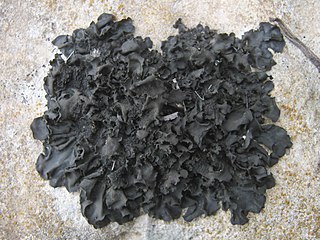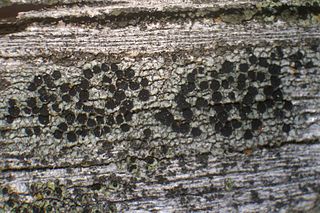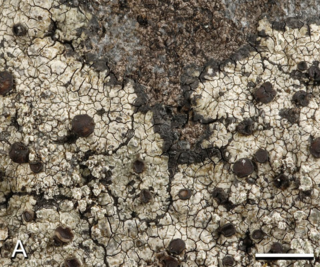
Collema is a genus of lichens in the family Collemataceae. The photobiont is the cyanobacterium genus Nostoc. Species in this genus typically grow on nutrient-rich bark or somewhat siliceous or calcareous rocks in humid environments.

Buellia is a genus of mostly lichen-forming fungi in the family Caliciaceae. The fungi are usually part of a crustose lichen. In this case, the lichen species is given the same name as the fungus. But members may also grow as parasites on lichens (lichenicolous). The algae in the lichen is always a member of the genus Trebouxia.

Immersaria is a genus of lichen-forming fungi in the family Lecideaceae. It has eight species of crustose lichens.

Scytinium is a genus of lichen-forming fungi in the family Collemataceae. It has 49 species. These lichens are typically found on basic rocks, soil, and trees, occasionally in association with mosses. Despite the morphological and ecological diversity within Scytinium, its species share similar ascospore features, such as shape and septation, as well as a small to medium-sized thallus with at least a partial cortex.
Biatora pacifica is a species of corticolous (bark-dwelling), crustose lichen in the family Ramalinaceae. It is found in Russia, Japan, and South Korea, where it grows along the Pacific coast. It inhabits the bark of a variety of coniferous and deciduous plants.
Pertusaria albineoides is a species of corticolous (bark-dwelling), crustose lichen in the family Pertusariaceae. Found on the Galápagos Islands, it was formally described as a new species in 2015 by Frank Bungartz, A.W.Archer, Alba Yánez-Ayabaca, and John Elix. The type specimen was collected on Alcedo Volcano at an altitude of 1,089 m (3,573 ft), where it was found growing on a partially shaded, rain- and wind-exposed trunk of Scalesia microcephala. The species epithet refers to the similarity to the species Pertusaria albinea, from which it differs by having thin-walled ellipsoid-shaped ascospores that are longer and narrower.

Biatora pontica is a species of corticolous (bark-dwelling), leprose lichen in the family Ramalinaceae. It is a widely distributed species, having been recorded in Africa, Asia, Europe, and North America.
Calogaya orientalis is a species of corticolous (bark-dwelling) and muscicolous lichen (moss-dwelling), crustose lichen in the family Teloschistaceae. It is found in arid steppe and desert habitats in Northwestern China, Iran, and Turkey. The thallus of this lichen is reduced, similar to species in the genus Athallia.
Lecidea lygommella is a species of saxicolous (rock-dwelling), crustose lichen in the family Lecideaceae. It spreads up to 7 cm wide with a thin thallus varying in colour from whitish and pale grey to rusty red-brown, featuring areolate surfaces with irregularly shaped areoles. Its fruiting bodies range from slightly embedded to sitting atop the thallus and black, flat to slightly convex apothecial discs. Unlike its lookalike Lecidea lygomma, L. lygommella does not produce any secondary chemicals. It is found in New South Wales and Victoria, Australia, where it grows on rocks in alpine areas.
Megalospora austropacifica is a species of corticolous (bark-dwelling), crustose lichen in the family Megalosporaceae. It is found on the islands of Taveuni and Viti Levu in Fiji. It has a yellowish grey to whitish grey, glossy thallus that is thick and may appear slightly wrinkled or smooth, often with irregular cracks and small papillae containing conidiomata, but lacking isidia and soredia. Its apothecia are circular, up to 4.5 mm in diameter, with the disc evolving from concave to slightly convex and coloured from orange-brown to red-brown, surrounded by a thick, prominent margin.
Placolecis kunmingensis is a species of saxicolous (rock-dwelling), crustose lichen in the family Catillariaceae. It is found in Yunnan, China. The lichen is characterised by a thallus that is areolate to squamulose in its centre, forming irregular patches or clumps 10–50 mm wide, as well as its ellipsoid or spherical ascospores with slightly thickened wall.
Malmidea leucopiperis is a species of corticolous (bark-dwelling), crustose lichen in the family Malmideaceae. It is found in Brazil.
Buellia lordhowensis is a little-known saxicolous (rock-dwelling), crustose lichen species in the family Caliciaceae, first described in 2020. It is only known to occur on Lord Howe Island, Australia.
Amandinea pilbarensis is a little-known species of crustose lichen in the family Physciaceae, First described in 2020, it is found in Australia. It is similar to Amandinea polyxanthonica, but can be distinguished by its smaller ascospores and the presence of calcium oxalate and thiophanic acid in the medulla.

Flavoplaca oasis is a species of saxicolous (rock-dwelling), crustose lichen in the family Teloschistaceae. It is widely distributed across Europe, and has been reported in Western Asia, China, and North Africa.

Glaucomaria is a genus of lichen-forming fungi in the family Lecanoraceae. It has seven species. The genus was circumscribed by Maurice Choisy in 1929. It contains crustose lichens formerly placed in the Lecanora rupicola species complex as defined by several previous authors.

Glaucomaria carpinea is a species of corticolous (bark-dwelling), crustose lichen in the family Lecanoraceae. It is a widely distributed species.

Sucioplaca is a single-species fungal genus in the family Teloschistaceae. It contains Sucioplaca diplacia, a saxicolous (rock-dwelling) crustose lichen. It is common and widely distributed in the Caribbean, Central America, and the Galápagos Islands, where it grows on coastal rocks.
Buellia stellulata, commonly known as the disc lichen) is a species of crustose lichen that is widely distributed throughout the Northern Hemisphere.
Buellia bahiana is a crustose-type lichen species that frequently grows on the bark and wood of trees found in coastal and inland forest habitats. This lichen species exhibits a broad geographic distribution, being documented in various pantropical and subtropical regions around the world. Specific areas where Buellia bahiana has been recorded include parts of Australia, Africa, North America, Central America, South America, and several Pacific Island chains.








